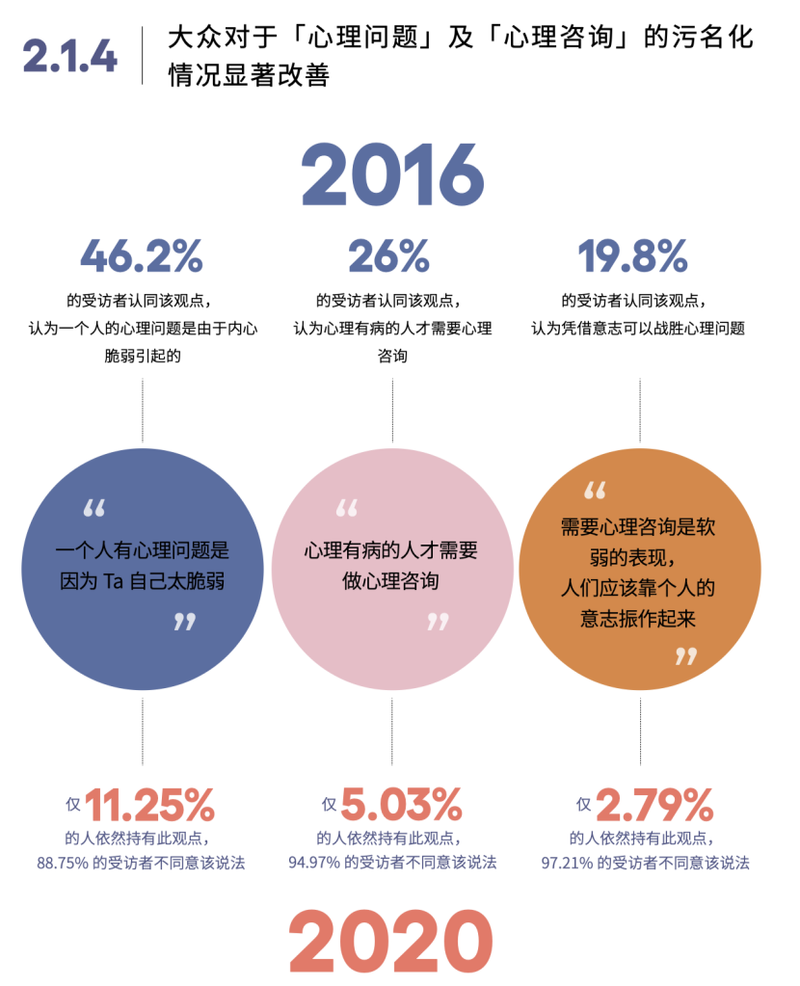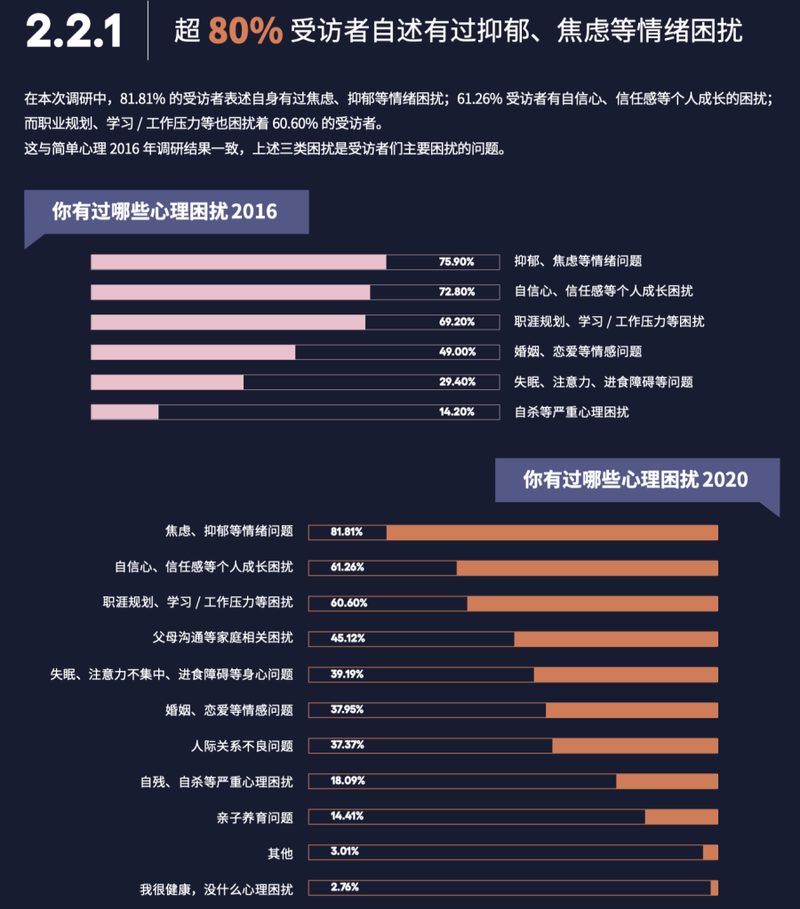type
status
slug
summary
tags
category
icon
password
ID
date
Author
URL
In 2020, only 11.25% of respondents believed that "only the weak will suffer from mental illness." The figure was 46.25% in 2016.
On January 12, 2021, Simple Psychology, a well-known online counseling appointment platform in China, released The 2020 China Public Mental Health Observation Report.
This is the fourth time the company has released this annual report. In order to expand the interviewees and obtain more balanced survey samples, they cooperated with well-known Chinese social networking sites such as Tencent, Zhihu, Weibo, recruitment website Lagou and well-known media Yimagzine.
In 2020, Chinese people have paid more attention to “mental health”. This is largely due to the Covid-19 outbreak. Sixty-five percent believed their mental health had been affected by the epidemic, with varying degrees of depression, anxiety, insomnia, and other acute stress reactions.
Among them, “news of the Covid-19 outbreak” and “inability to work and study properly” were cited as the main causes of anxiety. Therefore, in 2020, 78.34% of respondents said “mental health is very important and I am concerned about mental health”. That figure was just 50.5% four years ago.

In addition, at the level of public opinion, the “de-stigmatization” of mental illness is almost complete. According to the same survey in 2016, 46.25% believed that “only weak people could suffer from mental disorders,” 25 percent believed that “only people with abnormal minds needed counseling,” and 19.8 percent believed that “mental disorders could be overcome by their own will.”
In the new questionnaire for 2020, the proportion of these three groups fell to 11.25%, 5.03% and 2.79%, respectively. This means that Chinese people have significantly improved their awareness of mental disorders and mental illnesses, which they no longer associate with “weakness” and “impotence”. It also means there is no stigma attached to getting proper treatment.

The study also asked participants to rate whether they were affected by negative emotions, with 81.81 percent saying they had been affected by such emotions in 2020, topping the list with “anxiety and depression.”
The second most common emotional problem was “not feeling confident and trusted”, followed by “pressure from career and school” and “difficulty communicating with parents”. Notably, only 37.95% were “troubled by marriage and relationships,” ranking sixth. 14.41% were “troubled about educating their children.”
n 2016, “being troubled by marriage and relationships” ranked fourth, with 49% choosing that option. This means that the source of stress for Chinese people is shifting from communicating with their peers to communicating with their parents.
As can be seen from the ranking, work is still the third biggest cause of bad moods for Chinese people. In one subquestion, the report asked the subjects to explain what kind of negative emotions their work caused. 64.16% chose “anxiety”, 50.89% “sense of meaninglessness”, 49.9% “lack of purpose”, 40% “depression” and 37.62% “frustrated self-confidence”.
It seems that not wanting to work has become a reality rather than a joke, with 60% of respondents believing they are experiencing some degree of “job burnout”.
In the field of minors, the survey revealed a surprising result: Chinese students are more stressed by parents’ expectations and “incomprehension” than by endless exams.
According to the survey, one of the main sources of pressure for junior high school students is “parents’ expectations of themselves” and “communication barriers with parents” is one of their main sources of anxiety. As you get older, the stress of testing increases, but another source of stress grows even faster.
Only 50.48 percent of Chinese students in the third year of high school felt pressure over exams, while 57.14 percent felt pressure from “being confused about their future.” Another 41.9 percent of seniors “expect too much of themselves.” This seems to show the precocity of Chinese high school students, because we all know that these two sources of pressure are commonly referred to as “midlife crisis”.
For parents, the situation is very different. Although 74.4% of new mothers felt that they experienced varying degrees of “postpartum depression” in the first two years after birth, as the child grows up, educating the child is no longer a source of pressure, but a “life power”.
60% of new mothers believed their relationship with husbands grew closer after giving birth because they had a ‘common purpose to work towards’. But machismo was still a minor issue, with 11.11% of respondents believing they were experiencing “widowed parenting” – where their husbands were not involved in child care at all, except for money.
One of the sponsors of the survey was Simple Mind, an online booking platform for psychological counseling. According to a sample survey of its users throughout the year, nearly 80% of visitors aged between 21 and 35, and 60% were born in the 1990s.
Among the users who have paid for psychological counseling, 90 percent have a bachelor’s degree or above, and 22.62% are students at school. The number of people working in IT, electronics and communications was about 17.71%, the highest among all graduate groups.
Users in China’s first-tier cities (Beijing, Shanghai, Guangzhou and Shenzhen) were more willing to pay for psychological counseling. Paying users from these four cities account for 52.3% of the total. On the paid psychological counseling platform, paying users have had an average of 10 psychological counseling sessions in the past year, and their average annual expenditure is 5,633 yuan ($869), which means people choose an average of 560 yuan ($86.42) a time for psychological counseling.
Due to the epidemic, in 2020, the total number of “online consulting” surpassed “offline consulting” for the first time.
You can click here to download the original PDF version of the report (in Chinese):
- Author:NotionNext
- URL:https://pandayoo.com/2021/01/18/the-latest-report-shows-that-the-destigmatization-of-mental-illness-in-china-has-achieved-remarkable-success
- Copyright:All articles in this blog, except for special statements, adopt BY-NC-SA agreement. Please indicate the source!